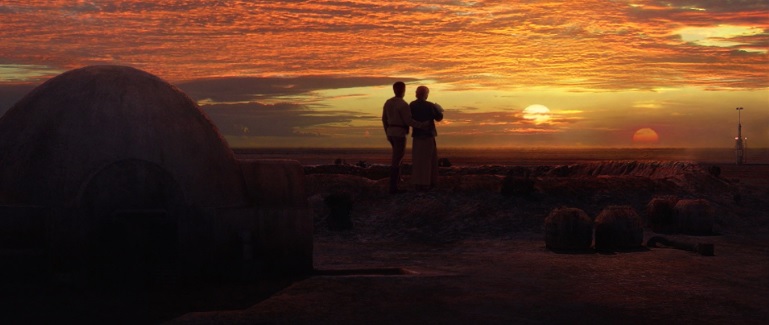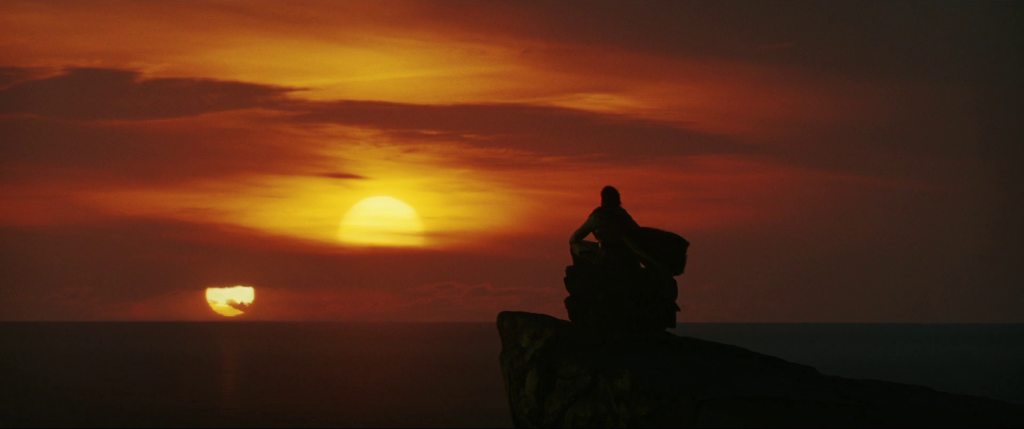The binary sunset scene in A New Hope is perhaps the iconic image of the film – so iconic that the saga has gone back to it time and again. For me as a child, it was the wonder of seeing something that felt real but also fantastical: a boy dreaming of adventures to come, but also a realistic-looking leap of the imagination, of what the alien spectacle of a binary star system would really look like from one of its planets. That combined with John Williams’s greatest ever theme, what became the Force Theme (though at the time was known as Ben Kenobi’s Theme).
When George Lucas returns to this moment, it is done very deliberately, during moments which encourage the audience to look simultaneously backwards and forwards across the span of the saga. The sequel trilogy films, too, have returned to this image twice, and those moments tell us much about the films themselves, their directors’ priorities and sensibilities, and speak to a wider conversation about the role of nostalgia in Star Wars going forward.
The Lucas films
Lucas first refers back to the sunset sequence – albeit indirectly – as Luke burns Vader’s armour at night on Endor, in Return of the Jedi. There are no binary suns here, but Luke is again framed in silhouette, and the rendition of the Force Theme uses the same orchestration as in ANH: the single French horn becoming the full orchestra. The repetition of that particular arrangement can only be a deliberate choice by Williams, creating the sense of musical “bookends” to Luke’s journey.

The sunset’s next true use, in Attack of the Clones, is an inversion of the original. Anakin looks out over that same ridge by the homestead, but we just see him, not the suns. This is not a moment of hope, it is a moment of fear, as Anakin prepares to set out to find his doomed mother. We next see Anakin and Padmé via their shadows, Anakin’s Padawan ponytail making his silhouette look suspiciously like Vader’s. We don’t see the suns until Anakin is tearing across the desert on his speeder bike, and by then the Force theme has gone, replaced by the ominous choir of Duel of the Fates. The effect, as with much of the “rhyming” in the prequel trilogy, is to contrast the journey of the father and the son – the similarities and the different paths chosen.
Lucas returns to the scene one final time at the end of Revenge of the Sith, as Obi-Wan hands baby Luke over to Owen and Beru at the homestead. By marking Luke’s birth in this way, Lucas has now established a tradition, that the key moments in Luke’s life will be symbolised by that sunset and that musical theme. As in ANH, the feeling is one of hope, new beginnings and the call to adventure, but also reminding us of that first/fourth film. We are looking backward and forward simultaneously. The use of that sunset then feels essential should we ever see Luke’s death.

The Last Jedi
When the twin suns appear to Luke on Ahch-To just before he fades into the Force, it is unclear whether they are really there, or Luke is just imagining them. The Visual Dictionary settles for making Ahch-To a binary star system, but I prefer the other explanation. Either way, Rian Johnson understands their role as part of Luke’s journey, and that this was the only correct way to end it.
Although their appearance marks Luke’s death, Johnson also understands that the suns have to represent more than that – they have to look to the future, not just the past. In the middle of the sunset is a brief shot of Rey as she connects with Luke through the Force, and she talks of him dying with “peace and purpose.” He is ascending into the Force, leaving Rey behind as the new hope of the Jedi, having passed on both his wisdom and his failures. His heroism will inspire the galaxy to rise up and fight the First Order. The baton has been passed, his work is done. It is a moment not of mourning, but of hope, and John Williams matches it with the biggest, most uplifting version of the Force Theme that we have ever heard.
TLJ is a film about passing on the baton to the next generation, and lays the path for a future for Star Wars that won’t be entirely defined by repeating the conflicts that have gone before. That binary sunset is the perfect ending to Luke’s journey, and I would argue that it is the last time we should have seen it. It was time for Episode IX to take us to new places, and forge a path forward beyond the Skywalker saga.

JJ Abrams and Chris Terrio had other ideas.
The Rise of Skywalker
Like the prequel trilogy, the sequel trilogy also ends with the twin suns of Tatooine. This time it is a sunrise rather than a sunset (though you have to be watching carefully to spot that). By now, though, there is a sense of this wearing a bit thin – “oh, that again?”
The problems are multiple. The Rise of Skywalker has not continued the story left at the end of TLJ. Luke’s sacrifice apparently had no effect on the galaxy at large, as the Resistance is as small as ever. The baton was passed to Rey, but TROS decides we need yet another film of baton-passing (highlighted by the lightsaber passing back and forth between Rey and Leia at the start of the film). This is now the third film in a row which is fundamentally about old heroes passing things on to the next generation, and the next generation have never been allowed to take the story forward themselves.
TROS takes us back to Tatooine as an appropriate place to bury Luke and Leia’s lightsabers. Yet the Skywalkers had few fond memories of Tatooine – where Anakin grew up as a slave and lost his mother, where Owen and Beru were murdered and Leia was enslaved by Jabba the Hutt. At a stretch you could argue that they are returning to Shmi’s home and burial place, but Shmi hasn’t been mentioned since Episode III, and the last Skywalker, Ben Solo, is essentially forgotten. This is about Luke and Leia. The primary reason to return to Tatooine is nostalgia, so the audience can see those suns one more time. TLJ understood that it was the suns that were important, not the desert, but for JJ Abrams, the most important thing was going back to the place where ANH started. Not giving us a sense of the sweep of the entire saga, but of just how important that film was to a young boy in 1977.
This tells us much about the priorities of TROS, where beats of nostalgia are used to draw a response from the audience, and their meaning to the characters is secondary. The reveal of Rey’s heritage (another element that should have been resolved in TLJ, but which the trilogy keeps going back to) actually affects very little: to Rey he’s a figure from distant history, and we already knew she had darkness in her because everyone does. The idea that specific dark powers like Force lightning are somehow directly inherited through blood, and that Rey is more inclined to be evil because her grandfather was, seems opposed to our understanding of the Force. Palpatine never even uses his relationship to Rey as a means of turning her – he’s still just a bad old man she has to kill because he’s threatening her friends. The lineage is for the audience, not for Rey’s story.
There are other examples. Ben Solo sacrifices himself and dies redeemed as his grandfather did, but is instantly forgotten without even a shot of him reunited with his family in the Force. Instead, the film shows us Chewbacca getting Han’s Yavin medal, a beat of nostalgia aimed directly at a small section of fandom who talked about Chewie’s lack of a medal in the early nineties, but haven’t kept up with the novels which had already resolved it. Star Wars as written for the guys from Clerks. Endor and Bespin are shown again during the final celebration montage, rather than the children of Pasaana, or the proles overthrowing the arms dealers of Canto Bight.
The main issue with the final shot is that it’s not really about Rey. The film treats it as a pilgrimage for her, but it’s a pilgrimage for the audience. We associate those suns with Luke’s journey. Rey’s new “family,” as Palpatine called Finn and Poe, are notable by their absence, because TROS recontextualises Rey’s desire for “belonging” as the simple need for a surname. As Rey looks out at the rising suns, Williams repeats the arrangement of the Force Theme he used at the end of TFA – an odd choice, as the way the orchestra rises into the end credits feels unresolved, even ominous. A version written for a cliffhanger, it certainly doesn’t feel like a catharsis. The suns mean nothing to Rey, and she remains a silhouette defined by the light of the previous generation. We are looking backwards, and there is little sense of us looking forwards.

Backward and Forward
When JJ Abrams made TFA, he said that he felt the need to refer to the iconography of the original trilogy so that the new era of Star Wars could go “backwards, in order to go forwards.” By the end of TROS, though, the trilogy has lurched firmly backward, never escaping the pattern of being primarily about the older characters, and there is little to suggest anything new going forward.
Episode IX was always going to be a difficult task, perhaps an impossible one. And if it was set up to be the end of the saga, maybe it was always just going to be little more than a bookend. Yet TLJ had already shown us a glimpse of the trilogy as the start of something new – that with that binary sunset on Ahch-To, the Skywalker story had drawn to a close, and Rey was going to take what was best from the past but not be shackled to it.
It seems that, for the moment, Lucasfilm is not interested in touching the post-TROS era. TV is taking is back to the Bad Batch, Cassian Andor, Obi-Wan Kenobi and more of The Mandalorian; publishing is taking us all the way back to the High Republic. There is a logic in this – two-thirds of the sequel trilogy was a co-production with Bad Robot, so Lucasfilm creatively has a closer relationship with The Clone Wars, Rebels, Rogue One, Solo and The Mandalorian than it does with TFA and TROS. But things have certainly changed since Kathleen Kennedy said in early 2017 that Lucasfilm was planning “years of stories” with Rey, Finn, Poe and BB-8.

Now that we have reached the end of this first iteration of Disney-Lucasfilm stories, the nostalgia issue is going to define what happens going forward. The sequel trilogy’s opportunity to set up the future was squandered. Let’s hope that Taika Waititi, whatever else he does, doesn’t give us another twin sunset.

